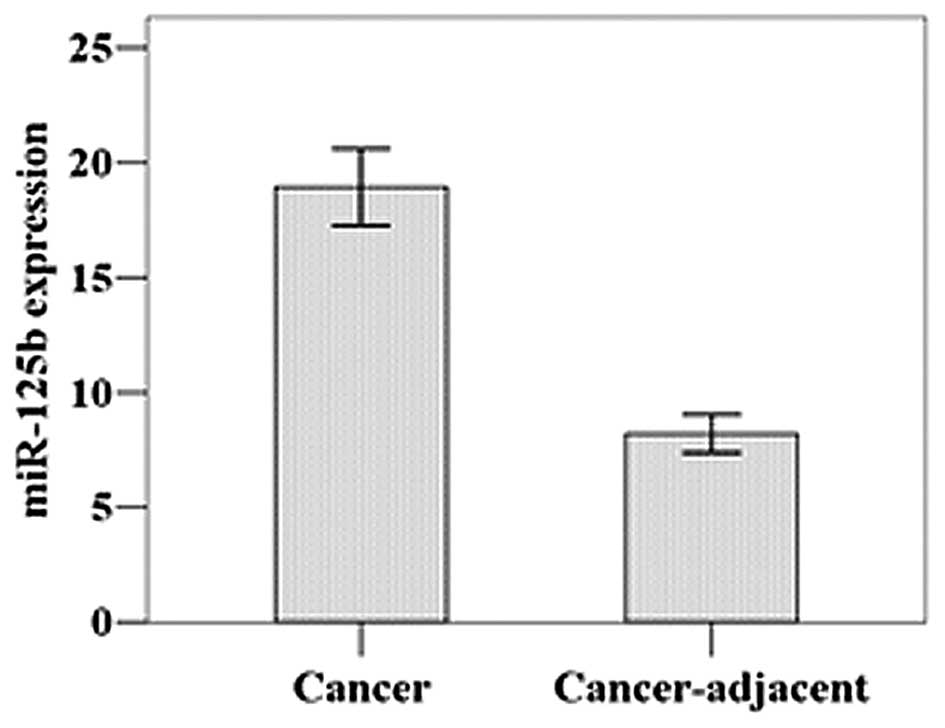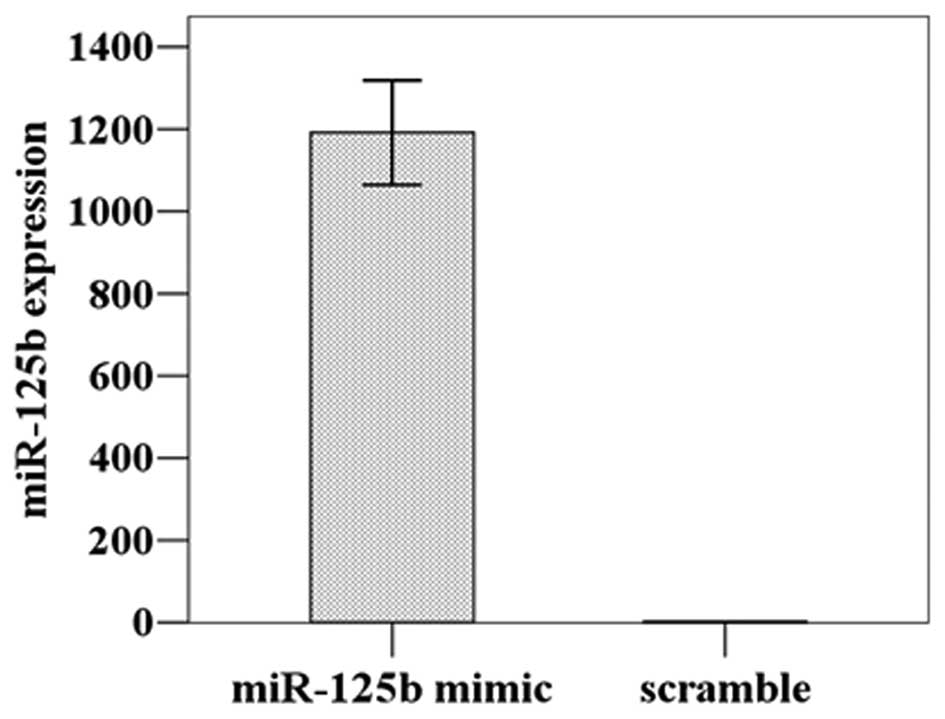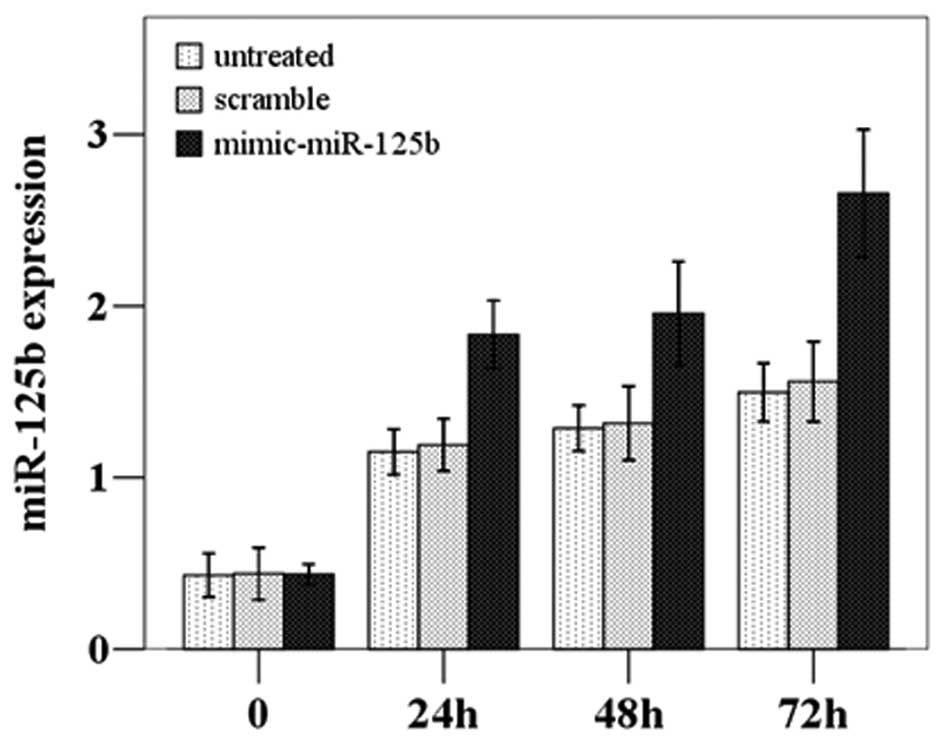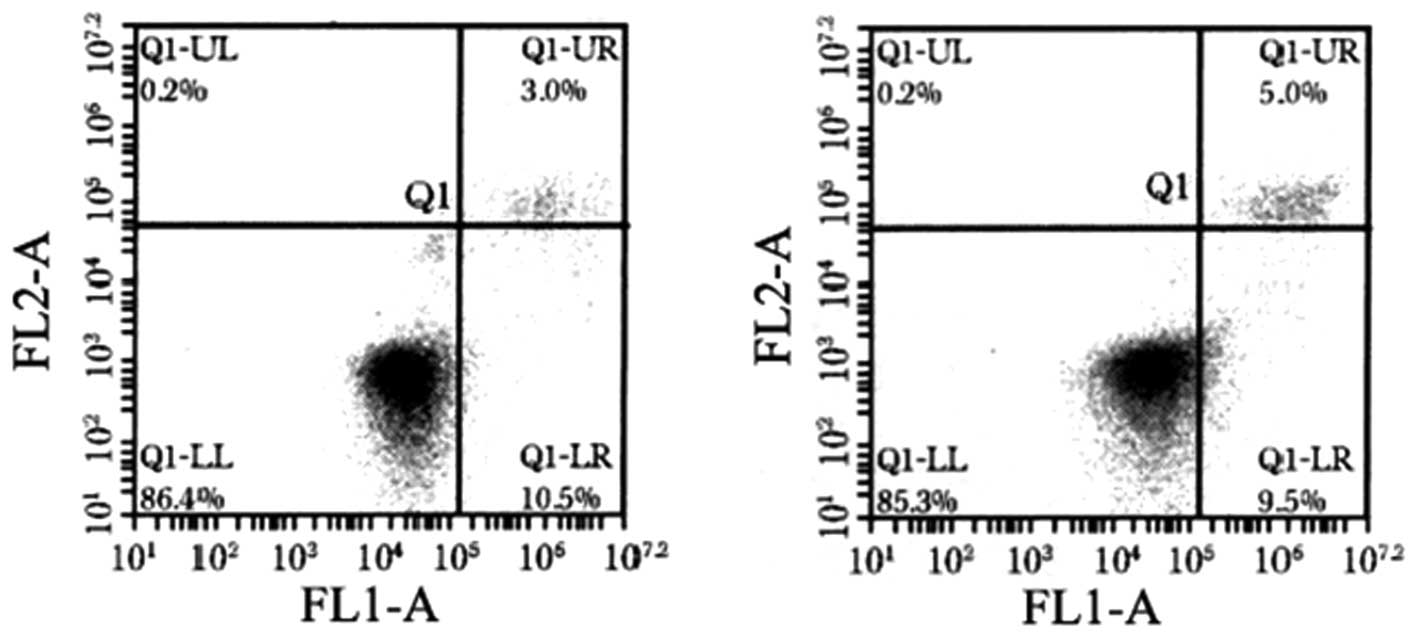MicroRNA-125b expression in gastric adenocarcinoma and its effect on the proliferation of gastric cancer cells
- Authors:
- Published online on: October 26, 2012 https://doi.org/10.3892/mmr.2012.1156
- Pages: 229-232
Abstract
Introduction
MicroRNAs (miRNAs) are a very important regulatory RNA molecules that influence gene function by inhibiting translation or inducing the degradation of target mRNA (1). Importantly, expression imbalances caused by miRNA regulation can contribute to the pathogenesis of various tumors (2). For example, miR-21 has been implicated in breast, colon, prostate and thyroid cancers, among others (2). The potent effect of miRNAs on disease processes indicates a need for studying their expression and function, with the aim of establishing a solid foundation for the clinical treatment of tumors (3–5).
Another miRNA, miR-125b, has been shown to exhibit abnormal expression in a variety of tumor tissues; however, its effects are not consistent across tissue types (6–8). In prostate cancer, the high expression of miR-125b can promote tumor proliferation (9), but, in breast cancer, miR-125b can significantly inhibit tumor proliferation (10). A certain study found that this miRNA exhibited altered expression in gastric cancer according to disease progression (11). However, no other reports on miR-125b expression and its effect on gastric cancer have been identified.
Gastric cancer occurs with high incidence in Asian populations and thus has been an important focus of cancer research (12). In this study, real-time PCR was used to detect miR-125b expression in 50 cases of gastric cancer tissues and corresponding adjacent normal tissues. To determine the effect of miR-125b on the proliferation and apoptosis of gastric cancer cells, the miR-125b mimic was transfected into the gastric cancer cell line, HGC-27. Our results reveal the potential functions of miR-125b in gastric cancer and may pave the way for its application in clinical diagnosis and treatment.
Materials and methods
Specimens
Specimens of both gastric carcinoma tissues and corresponding adjacent normal tissues (>5 cm away from cancer tissues) were collected from 50 patients who received surgical resection of gastric cancer from January 2010 to December 2011 in Xijing Hospital, the Fourth Military Medical University, Xi’an, China. Gastric cancer diagnoses were confirmed by post-operative pathological biopsy. No patients had received pre-operative radiotherapy, chemotherapy or endocrine therapy. The age range of the patients was 32–70 years and the mean age was 53.9±9.6 years. During surgery, the cancer and adjacent normal tissues were cut, 100 mg of which were washed with 1X PBS, placed in cryovials and kept in a refrigerator at −80°C.
Cell culture and transfection
The HGC-27 human gastric cancer cells were provided by the Cell Bank of the Shanghai Institute of Cell Biology (Chinese Academy of Sciences, Shanghai, China) and placed in DMEM medium (Gibco-BRL, Carlsbad, CA, USA) containing 10% FBS (PAA Laboratories, Pasching, Austria), 1×105 IU/l penicillin and 1×105 IU/l streptomycin and conventionally cultured in an incubator at 37°C, 5% CO2. One day prior to transfection, the cell culture medium was transferred at a density of 1×104 cells/ml to prepare for transfection during the logarithmic growth phase. Cells were washed once with serum-free medium, then resuspended in complete medium without antibiotics at a cell concentration of 4×105 in a volume of 1,500 μl. Suspensions were transferred onto a 6-well plate and placed in DMEM overnight without serum and antibiotics. Transfections were performed with DharmaconFECT1 (Dharmacon, Inc., Lafayette, CO, USA), using 100 pmol mimic-miR-125b (Dharmacon Inc.) per well in the transfection group and 100 pmol negative control (Dharmacon Inc.) per well in the control group. After 6 h of culture at 37°C, 5% CO2, 500 μl of 10% FBS-supplemented medium were added and the cells were continuously cultured for 72 h.
Detecting cell proliferation with CCK-8
Suspensions containing 5×104 cells/ml were prepared and 100 μl of suspension were added to a 96-well plate. Cells were continuously cultured at 37°C. At 24, 48 and 72 h after culture, 10 μl CCK-8 solution (Dojindo, Kunamoto, Japan) were added to each well before an additional incubation at 37°C for 4 h. The optical density of the suspensions was then determined by absorbance at 450 nm.
Detecting cell apoptosis with FITC-Annexin V
The cells were collected into 10-ml centrifuge tubes and washed with incubation buffer. Following centrifugation at 800 rpm for 5 min, the cells were resuspended in 100 μl FITC-Annexin V-PI (BD Biosciences, Franklin Lakes, NJ, USA) labeling solution and incubated at room temperature in the dark for 15 min. Following another centrifugation at 800 rpm for 5 min, the cells were washed with incubation buffer. Fluorescent dye solution was added and the cells were incubated at 4°C for 20 min in the dark with occasional mixing. The excitation wavelength for flow cytometry was 488 nm; FITC was detected at 515 nm and PI was detected at >560 nm. Data were plotted in bivariate flow cytometry scatter plots: the lower left quadrant (FITC−/PI−) shows living cells; the upper right quadrant (FITC+/PI+) shows non-living cells, namely, necrotic cells; the lower right quadrant (FITC+/PI−) indicates apoptotic cells.
Quantitative real-time PCR
TRIzol reagent (Invitrogen Life Technologies, Carlsbad, CA, USA) was used according to the manufacturer’s instructions to extract the total cellular RNA from the tissue specimens; RNA purity and concentration were determined by UV spectrophotometry. MiRNA 1st-strand cDNA was synthesized by stem-loop primer reverse transcription reaction (Promega Corp., Madison, WI, USA). The following primer sequences were used: Hsa-miR-125b RT primer, 5′-GTCGTATCCAGTGCAGGGTCCGAGGTATTCGCACTGGATACGACTCACAAG-3′; Hsa-miR-125b sense primer, 5′-GGATTCCCTGAGACCCTAAC-3′; Hsa-miR-125b antisense primer, 5′-GTGCAGGGTCCGAGGT-3′; U6 RT primer, 5′-AAAATATGGAACGCTTCACGAATTTG-3′; U6 sense primer, 5′-CTCGCTTCGGCAGCACATATACT- 3′; U6 antisense primer, 5′-ACGCTTCACGAATTTGCGTGTC-3′. The real-time quantitative PCR kit (Takara Bio., Inc., Shiga, Japan) was used to facilitate the reactions. Reactions were performed under the following thermal cycling conditions: 94°C for 20 sec; and 40 cycles of 94°C for 30 sec, 60°C for 45 sec. Samples were amplified in triplicate and reactions were performed on a Bio-Rad IQ5 PCR instrument (Bio-Rad, Hercules, CA, USA) which was also used to analyze the results.
Statistical analysis
SPSS17.0 statistical software was applied to statistical analysis. Measurement data are expressed as the means ± standard deviation (SD). A two-independent-sample t-test was used to compare the miR-125b expression between the groups. The above analyses were performed with two-sided tests, with a test level (α) of 0.05 and P<0.05 was considered to indicate a statistically significant difference.
Results
MiR-125b expression in gastric cancer and adjacent non-cancerous tissues
As shown by real-time PCR, the relative mean miR-125b expression level was 18.94±5.96 in the gastric cancer tissues and 8.20±2.91 in the adjacent normal tissues (Fig. 1). This difference was statistically significant (t=11.452, P=0.001).
Effect of miR-125b overexpression on HGC-27 cell proliferation
The miR-125b expression level was detected at 1192.00±109.77 in the HGC-27 cells transfected with miR-125b mimic, a significant increase of approximately 1000-fold compared to the cells treated with the scrambled miRNA (1.29±0.18) (t=18.788, P=0.001); thus, the transfection was successful (Fig. 2). The subsequent CCK8 proliferation assay demonstrated that the proliferation was significantly increased in the miR-125b-overexpressing cells compared to the untreated and scramble-treated cells (F=23.095, P=0.002) (Fig. 3).
Effect of miR-125b overexpression on HGC-27 cell apoptosis
To determine whether the apoptosis of HGC-27 cells is also dysregulated when miR-125b is overexpressed, the cells were analyzed by flow cytometry for Annexin V. The proportion of Annexin V-positive cells was decreased when miR-125b was overexpressed, which can be observed mainly as the percentage of cells in early apoptosis (lower right quadrant, Fig. 4). Furthermore, in HGC-27 cells expressing the miR-125b mimic, the early and late apoptotic rates were different compared to the scramble-treated and untreated cells (P<0.05, Table I).
Discussion
The potent ability of miRNAs to regulate a variety of physiological and pathological processes is well-accepted as a key component of gene expression regulatory networks in eukaryotes. Indeed, these molecules exert effects on cell proliferation and apoptosis, organismal growth and development, hematopoiesis and organ formation (13). Recent studies on tumor-associated miRNAs have uncovered roles for a number of miRNA molecules in tumorigenesis, as well as in cancer diagnosis and prognosis (2,14).
Our current study on the expression of miR-125b (previously implicated in other tumors types), in gastric cancer confirms the results from a previous study, demonstrating its dysregulation in this type of cancer (11). Furthermore, the overexpression of this miRNA in gastric cancer cells in vitro revealed the affects on cellular proliferation and apoptosis; proliferation was increased and apoptosis decreased when miR-125b was overexpressed. The dysregulation of these cellular processes by miR-125b may promote tumor initiation and progression. These results indicate that miR-125b plays an important role in the pathogenesis of gastric cancer. Further studies are required to determine whether miR-125b represents a potential oncogenic target for the diagnosis and treatment of gastric cancer.
Acknowledgements
This study was supported by the National Science Foundation of China (grant no. 81000164).
References
|
Iorio MV and Croce CM: MicroRNAs in cancer: small molecules with a huge impact. J Clin Oncol. 27:5848–5856. 2009. View Article : Google Scholar : PubMed/NCBI | |
|
Nikitina EG, Urazova LN and Stegny VN: MicroRNAs and human cancer. Exp Oncol. 34:2–8. 2012. | |
|
Esquela-Kerscher A and Slack FJ: Oncomirs-microRNAs with a role in cancer. Nat Rev Cancer. 6:259–269. 2006. View Article : Google Scholar | |
|
Hobert O: Gene regulation by transcription factors and microRNAs. Science. 319:1785–1786. 2008. View Article : Google Scholar : PubMed/NCBI | |
|
Kota J, Chivukula RR, O’Donnell KA, et al: Therapeutic microRNA delivery suppresses tumorigenesis in a murine liver cancer model. Cell. 137:1005–1017. 2009. View Article : Google Scholar : PubMed/NCBI | |
|
Xu N, Brodin P, Wei T, et al: MiR-125b, a microRNA downregulated in psoriasis, modulates keratinocyte proliferation by targeting FGFR2. J Invest Dermatol. 131:1521–1529. 2011. View Article : Google Scholar : PubMed/NCBI | |
|
Shi XB, Xue L, Ma AH, Tepper CG, Kung HJ and White RW: miR-125b promotes growth of prostate cancer xenograft tumor through targeting pro-apoptotic genes. Prostate. 71:538–549. 2011. View Article : Google Scholar : PubMed/NCBI | |
|
Glud M, Rossing M, Hother C, et al: Downregulation of miR-125b in metastatic cutaneous malignant melanoma. Melanoma Res. 20:479–484. 2010. View Article : Google Scholar : PubMed/NCBI | |
|
Shi XB, Xue L, Yang J, et al: An androgen-regulated miRNA suppresses Bak1 expression and induces androgen-independent growth of prostate cancer cells. Proc Natl Acad Sci USA. 104:19983–19988. 2007. View Article : Google Scholar | |
|
Scott GK, Goga A, Bhaumik D, Berger CE, Sullivan CS and Benz CC: Coordinate suppression of ERBB2 and ERBB3 by enforced expression of micro-RNA miR-125a or miR-125b. J Biol Chem. 282:1479–1486. 2007. View Article : Google Scholar : PubMed/NCBI | |
|
Ueda T, Volinia S, Okumura H, et al: Relation between microRNA expression and progression and prognosis of gastric cancer: a microRNA expression analysis. Lancet Oncol. 11:136–146. 2010. View Article : Google Scholar : PubMed/NCBI | |
|
Lochhead P and El-Omar EM: Helicobacter pylori infection and gastric cancer. Best Pract Res Clin Gastroenterol. 21:281–297. 2007. View Article : Google Scholar : PubMed/NCBI | |
|
Bartel DP: MicroRNAs: genomics biogenesis, mechanism and function. Cell. 116:281–297. 2004. View Article : Google Scholar : PubMed/NCBI | |
|
Croce C: Introduction to the role of microRNAs in cancer diagnosis, prognosis and treatment. Cancer J. 18:213–214. 2012. View Article : Google Scholar : PubMed/NCBI |













